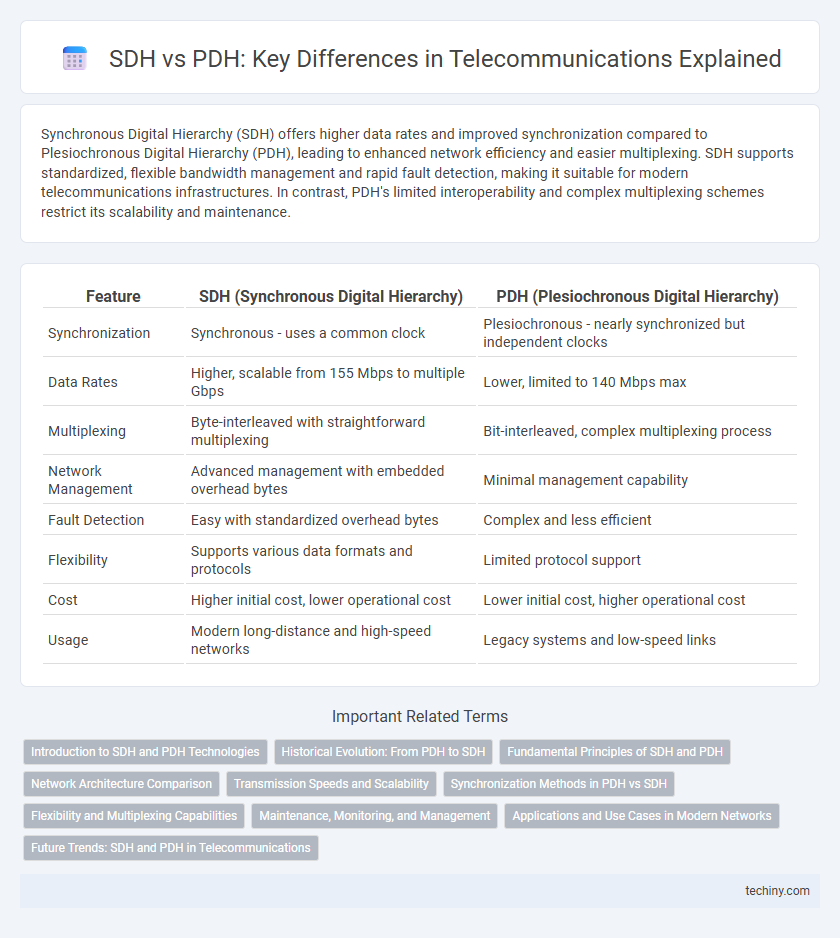Synchronous Digital Hierarchy (SDH) offers higher data rates and improved synchronization compared to Plesiochronous Digital Hierarchy (PDH), leading to enhanced network efficiency and easier multiplexing. SDH supports standardized, flexible bandwidth management and rapid fault detection, making it suitable for modern telecommunications infrastructures. In contrast, PDH's limited interoperability and complex multiplexing schemes restrict its scalability and maintenance.
Table of Comparison
| Feature | SDH (Synchronous Digital Hierarchy) | PDH (Plesiochronous Digital Hierarchy) |
|---|---|---|
| Synchronization | Synchronous - uses a common clock | Plesiochronous - nearly synchronized but independent clocks |
| Data Rates | Higher, scalable from 155 Mbps to multiple Gbps | Lower, limited to 140 Mbps max |
| Multiplexing | Byte-interleaved with straightforward multiplexing | Bit-interleaved, complex multiplexing process |
| Network Management | Advanced management with embedded overhead bytes | Minimal management capability |
| Fault Detection | Easy with standardized overhead bytes | Complex and less efficient |
| Flexibility | Supports various data formats and protocols | Limited protocol support |
| Cost | Higher initial cost, lower operational cost | Lower initial cost, higher operational cost |
| Usage | Modern long-distance and high-speed networks | Legacy systems and low-speed links |
Introduction to SDH and PDH Technologies
Synchronous Digital Hierarchy (SDH) and Plesiochronous Digital Hierarchy (PDH) are key telecommunications transmission technologies used for multiplexing digital signals. SDH offers a scalable, standardized framework supporting higher data rates and improved network management compared to the older PDH, which operates with slightly asynchronous timing and limited interoperability. SDH's synchronous structure enables efficient bandwidth allocation and seamless integration across global networks, crucial for modern high-speed communication demands.
Historical Evolution: From PDH to SDH
The transition from Plesiochronous Digital Hierarchy (PDH) to Synchronous Digital Hierarchy (SDH) marked a significant milestone in telecommunications, driven by the need for standardized, high-capacity, and easily manageable networks. PDH networks, developed in the 1960s and 1970s, faced limitations in scalability and interoperability due to their asynchronous nature and diverse regional formats. SDH, introduced in the late 1980s, provided a globally unified framework with improved synchronization, simplified multiplexing, and enhanced network management capabilities, ultimately enabling efficient transport of vast digital data streams across wide-area optical fiber networks.
Fundamental Principles of SDH and PDH
Synchronous Digital Hierarchy (SDH) operates on a synchronized, standardized time frame that enables seamless multiplexing of multiple PDH signals with enhanced network management and scalability. Plesiochronous Digital Hierarchy (PDH) relies on slightly asynchronous clocks for each transmission path, resulting in complex multiplexing techniques and limited interoperability between different vendors' equipment. SDH's use of fixed-length frames and pointer adjustments fundamentally improves synchronization accuracy and bandwidth efficiency compared to PDH's variable multiplexing structure.
Network Architecture Comparison
Synchronous Digital Hierarchy (SDH) offers a unified, standardized network architecture designed for seamless multiplexing and interoperability across diverse telecommunications systems, unlike the older Plesiochronous Digital Hierarchy (PDH) which relies on non-synchronized, legacy multiplexing methods. SDH's hierarchical structure facilitates efficient bandwidth management through fixed-length frames and synchronous timing, enabling superior scalability and easier network maintenance. PDH networks typically suffer from complex multiplexing hierarchies and limited performance in handling modern high-speed data traffic, making SDH the preferred choice for contemporary telecommunications infrastructure.
Transmission Speeds and Scalability
Synchronous Digital Hierarchy (SDH) offers significantly higher transmission speeds, supporting rates from 155 Mbps up to multiple Gbps, while Plesiochronous Digital Hierarchy (PDH) is limited to lower speeds, commonly up to 140 Mbps. SDH's structured multiplexing and frame alignment enable seamless scalability and easier capacity expansion across optical networks, contrasting with PDH's complex and less flexible multiplexing hierarchy. Telecom providers favor SDH for its superior scalability and efficient bandwidth management in high-speed backbone transmission systems.
Synchronization Methods in PDH vs SDH
PDH (Plesiochronous Digital Hierarchy) uses independent clocks at each network node, leading to slight timing variations and the need for complex bit-stuffing to manage synchronization discrepancies. In contrast, SDH (Synchronous Digital Hierarchy) employs a unified, highly precise synchronization mechanism with a master clock distribution that ensures network-wide timing alignment, minimizing jitter and simplifying multiplexing. This synchronization improvement enables SDH to support higher data rates and enhance network reliability compared to PDH systems.
Flexibility and Multiplexing Capabilities
SDH (Synchronous Digital Hierarchy) offers superior flexibility compared to PDH (Plesiochronous Digital Hierarchy) by enabling synchronized multiplexing and easier network management. SDH supports dynamic multiplexing of lower-order signals with efficient bandwidth allocation, enhancing scalability for various data rates. In contrast, PDH relies on asynchronous multiplexing, which limits its adaptability and complicates the extraction and insertion of individual channels.
Maintenance, Monitoring, and Management
SDH (Synchronous Digital Hierarchy) offers enhanced maintenance capabilities with real-time fault detection and automated alarm systems, reducing downtime compared to PDH (Plesiochronous Digital Hierarchy). SDH supports comprehensive network management protocols like OSI and SNMP, enabling efficient monitoring and remote diagnostics, whereas PDH relies on manual and less sophisticated fault identification methods. The synchronization features of SDH allow more precise performance monitoring and simplified troubleshooting, optimizing overall network reliability and operational efficiency.
Applications and Use Cases in Modern Networks
SDH (Synchronous Digital Hierarchy) is widely applied in modern telecommunications networks for high-speed data transport and seamless integration with IP-based systems, supporting backbone infrastructure for ISPs and mobile operators. PDH (Plesiochronous Digital Hierarchy) remains in legacy networks, primarily used in regional and lower-capacity links where cost-effective solutions suffice without the need for synchronization precision. SDH enables real-time applications like video conferencing and VoIP through its synchronous multiplexing, whereas PDH suits basic voice and data transmission in less demanding environments.
Future Trends: SDH and PDH in Telecommunications
Future trends in telecommunications highlight the gradual shift from Plesiochronous Digital Hierarchy (PDH) to Synchronous Digital Hierarchy (SDH) due to SDH's superior scalability, flexibility, and standardized multiplexing capabilities. SDH supports higher data rates and better network management, enabling seamless integration with emerging technologies like optical transport networks (OTN) and next-generation 5G infrastructure. While PDH remains in legacy systems, SDH's enhanced synchronization and fault management position it as the backbone for future high-speed telecommunications networks.
SDH vs PDH Infographic

 techiny.com
techiny.com